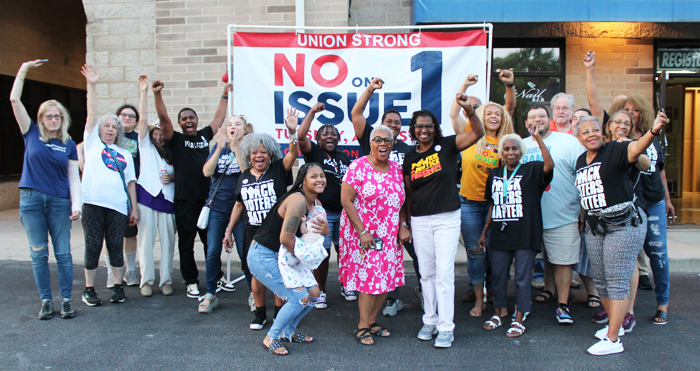
By Fletcher Word
The Truth Editor
The votes are in and Ohioans have decided they want to hold on to democracy … for a little while longer.
On Tuesday, the state’s voters overwhelmingly rejected a move by Republican legislators to effectively prevent citizen-initiated constitutional amendments from appearing on a ballot, or if they did appear, prevent the passage of such initiatives.
The vote totals were 56.3 percent opposed to Issue 1 with 43.5 percent in the “yes” column.
The Republican-dominated legislature, with the full-throated support of Ohio Secretary of State Frank LaRose, had cast aside their previous decision in January of this year to eliminate costly, low-turnout special elections in August. They decided in June, when faced with the prospect of a citizen-initiated ballot constitutional amendment in November affirming peoples’ right to reproductive freedom, to reverse course and place a measure on a special election August ballot to change the requirements for such amendments. Under the proposal, constitutional amendments would require 60 percent of voters rather than a simple majority.
In addition, in order to place the amendment proposal on the ballot, such citizen groups would have been required to obtain five percent signatures from eligible voters in all 88 counties rather than the current standard of 44 counties. In the 111 years since Ohio first granted voters the power to initiate citizen amendments, only 19 of 71 proposed amendments have passed the simple majority threshold.
So, Issue 1 would have set the bar at 60 percent. And for good reason, Republicans decided.
Republican legislators only had to look around the country to determine where they had to draw the line. The state of Kansas, for example, offered Republicans a valuable lesson in the support reproductive rights might have amongst the electorate. In August 2022, Kansans defeated a legislative-referred constitutional amendment to the state constitution to further restrict abortion rights. They defeated the proposed amendment by a 59.16 percent majority.
However, Issue 1 was not about abortion, said any number of Republicans. It was about protecting the Ohio constitution from the less-than-serious whims of the people and from the out-of-state special interest groups that would buy their way to victory at the polls.
Republican Senate President Matt Huffman called the August ballot measure a move to prevent “the tyranny of the majority.” He was clearly comfortable with a tyranny of the minority knowing that if the measure had passed, 41 percent of Ohio’s voters could have their way at the ballot box and 50 Ohio House members and 17 Senate members would be able to ignore the wishes of that majority.
Not all Republicans were quite so evasive about the real reason for placing Issue 1 on the ballot in an August special election just in time to change the rules for the upcoming November general election. LaRose was among the few who declared that this was all about abortion. Of course, LaRose, who has announced his candidacy for the U. S. Senate seat that is currently occupied by Sherrod Brown and who is up for re-election in 2024, has taken quite a beating in the media for his missteps in this whole special election debacle.
“Secretary of State Frank LaRose has spent more than a month traveling the state trying to persuade voters to emasculate themselves,” wrote Today in Ohio. “He failed miserably.”
Even after the results came in, LaRose, displaying unbounded hypocrisy, issued a statement blaming out-of-state interests with their deep-pocket investments for the defeat while ignoring the fact that the ballot initiative was funded by just such out-of-state deep pockets.
Chief among those out-of-state donators who backed Issue 1 was Richard Uilein of Illinois who kicked in $4 million to chip away at democracy in Ohio.
Ohioans were more than motivated to get to the polls for this divisive ballot issue. Two-point eight mission voters went to the polls, a remarkable turnout considering only 1.66 million voted in the last primary election that featured races for governor, for the U.S. Senate and for the seats in the U.S. Hose of Representatives.
Next up, on the abortion issue, is the November constitutional amendment. After the U.S. Supreme Court overturned Row v. Wade, the Ohio legislature passed some to the nation’s strictest curbs on abortion – banning the procedure as early as six weeks into pregnancy. The state Supreme Court is currently considering the constitutionality of those bans.
The November amendment would vacate that law and give women legal control over reproductive decisions, allowing doctors to make medical judgments on the need for abortions and restrict the state to regulating abortions only after a fetus is judged viable.
